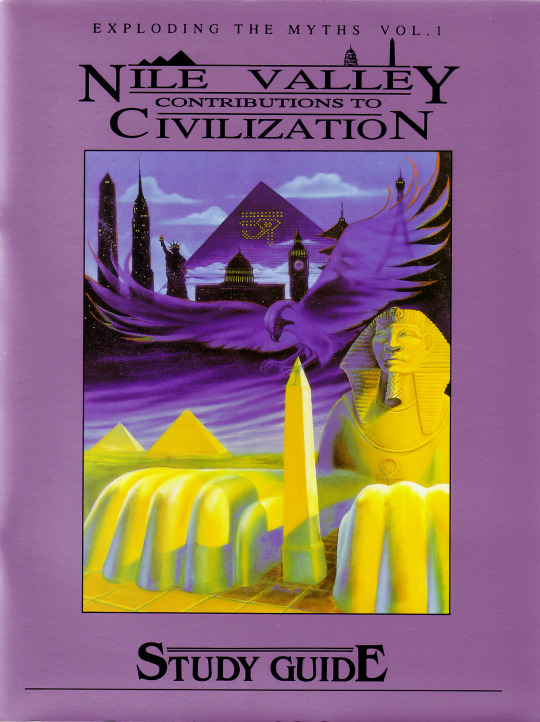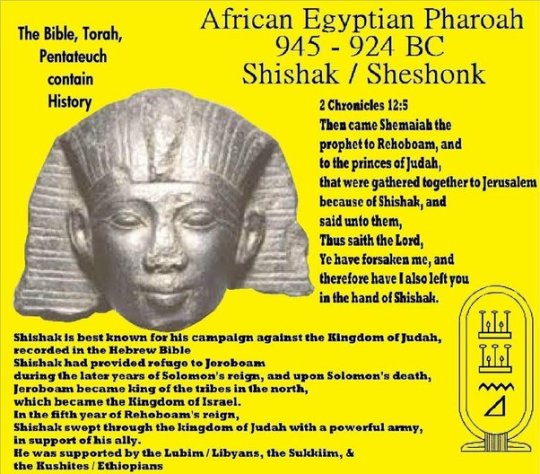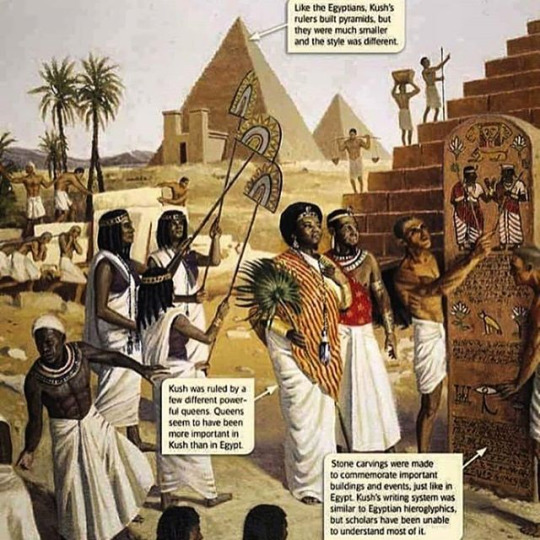#Kushites
Explore tagged Tumblr posts
Text

Egyptians Versus Kushites
It’s a clash of empires in northeastern Africa as the armies of ancient Egypt and Kush vie for control over the Nile Valley. If you need to know who’s who in this scene, the Egyptians are the guys with the blue and gold sashes on the left side of the composition whereas the Kushites are the dudes with red sashes on the right.
#ancient egypt#egyptian#kemet#ancient kush#kushites#nubian#african#nile valley#black men#dark skin#bipoc#battle scene#ancient#historical#warfare#digital art#art#illustration
7 notes
·
View notes
Photo

Nile Valley Contributions to Civilization
37 notes
·
View notes
Text
The Temple of Derr: A Historical African Marvel in Lower Nubia
The Temple of Derr, also known as el-Derr, stands as a testament to the might and grandeur of ancient Egyptian architecture. Constructed during the 19th dynasty by the renowned Pharaoh Ramesses II, this magnificent rock-cut temple holds a significant place in the history of Nubia. Situated in New Amada, in Lower Nubia, the Temple of Derr is the sole rock-cut temple in Nubia attributed to Pharaoh…

View On WordPress
#African architecture#ancient egyptian architecture#Ancient Egyptians#ancient egyptians history#Kushites#Nubia#Nubian history#Pharaoh Ramesses II#The Temple of Derr
2 notes
·
View notes
Photo

17 notes
·
View notes
Text

HYKSOS???
If the direct translation of Hyksos is “rulers of a foreign country” then wouldn’t Nefertiti and Akhenaten be considered foreigners to the land? It explains the connection between Abraham and Hammurabi with ease.
Moreover, it flies in the face of more recent theories that all of the dynasties of Egypt we think of were Semitic in origin. I mean, 1750 BCE is almost 1,500 years after a Kushite by the name of Menes unified North and South Egypt and set up the first dynasty.
Or, hear me out. Is it because of the way we lump together groups with the term Semitic that’s the issue. It was created by a linguist who observed the sons of Shem spoke a set of related languages. Unfortunately, the verse in Genesis that ties the sons of Shem together does so by blood. So now, we associate the Semitic language with constructs like race instead of culture.
Somebody with a more extensive grasp on history please jump in and explain this. I’m genuinely perplexed.
17 notes
·
View notes
Text
sometimes I see a statue of archeological significance and can’t stop thinking “damn. that bitch had the baddest body of 700 BCE”
271 notes
·
View notes
Text

@_africanhistory :
The Ten Commandments are a condensed version of the 42 Declarations of Ma'at from ancient Kemet, stripped of their original context and power.
#ma’at#kushite#kemetic#spirituality#science#blackout#world history#black history#ten commandments#religion
178 notes
·
View notes
Text
Rebranding
Hi everyone! I've recently been growing a big interest in Etruscan Polytheism and Kushite Polytheism (the religions of ancient Etruria and the kingdom of Kush). So once I get things going I may rebrand this blog so it's geared towards those pantheons.
They are currently very niche, but I am very excited and can't wait to share about them so they get the love they deserve ♥️
I may also go into Punic Polytheism!! So stay tuned.
Please interact if any of these pantheons interests you too! (even if you don't plan on worshipping, but would like to learn more!)
#etrupol#raspol#etruscan polytheism#etruscan paganism#etruscan#etruscan polytheist#kushite#kushite religion#kushite polytheism#kushite paganism#kushite pagan#kemetic#punic#punic polytheism#punic paganism#punic polytheist#punic pagan#carthage
12 notes
·
View notes
Text
Led a combined Kushite/Egyptian assault on Rome in Total War: Rome II today. My Egyptian allies didn't do so hot, but I was able to have my Kushite forces break in and lay waste to those greasy Romans in their own city!
(Honestly, Cleopatra and Amanirenas teaming up to eliminate the Roman threat once and for all would make a fun alt-history scenario.)
#total war#total war: rome 2#gaming#real-time strategy#ancient kush#kushites#nubian#african#nile valley#bipoc#ancient rome#roman#alternate history
0 notes
Text

27 notes
·
View notes
Text
The Kingdom of Kush: An Ancient Civilization in the Nile Valley
The Kingdom of Kush, also known as the Kushite Empire, holds a significant place in the annals of ancient history. This powerful kingdom flourished in Nubia, an area along the Nile Valley encompassing present-day northern Sudan and southern Egypt. With a rich and complex history, the Kingdom of Kush emerged as a formidable force, engaging in warfare, trade, and cultural exchange with neighboring…

View On WordPress
#African History#ancient Egypt#Kingdom of Kush#Kushite civilization#Kushite History#Kushites#Nile Valley#north african culture#North African History#Nubian history
3 notes
·
View notes
Text

Kandake, kadake or kentake (Meroitic: 𐦲𐦷𐦲𐦡 kdke), often Latinised as Candace (Ancient Greek: Κανδάκη, Kandakē), was the Meroitic term for the sister of the king of Kush who, due to the matrilineal succession, would bear the next heir, making her a queen mother.

Pliny writes that the "Queen of the Ethiopians" bore the title Candace, and indicates that the Ethiopians had conquered ancient Syria and the Mediterranean.
In 25 BC the Kush kandake Amanirenas, as reported by Strabo, attacked the city of Syene, today's Aswan, in territory of the Roman Empire; Emperor Augustus destroyed the city of Napata in retaliation.
Cassius Dio wrote that Kandake's army advanced as far as the Elephantine in Egypt, but Petronius defeated them and took Napata, their capital, and other cities.
Four African queens were known to the Greco-Roman world as the "Candaces": Amanishakheto, Amanirenas, Nawidemak, and Malegereabar

Biblical usage
The Baptism of Queen Candace's Eunuch (c. 1625–30, attributed to Hendrick van Balen and Jan Brueghel the Younger)
In the New Testament, a treasury official of "Candace, queen of the Ethiopians", returning from a trip to Jerusalem, met with Philip the Evangelist:
Now an angel of the Lord said to Philip, "Rise and go toward the south to the road that goes down from Jerusalem to Gaza." This is a desert place. And he rose and went. And there was an Ethiopian, a eunuch, a court official of Candace, queen of the Ethiopians, who was in charge of all her treasure. He had come to Jerusalem to worship
He discussed with Philip the meaning of a perplexing passage from the Book of Isaiah. Philip explained the scripture to him and he was promptly baptised in some nearby water. The eunuch 'went on his way, rejoicing', and presumably therefore reported back on his conversion to the Kandake

Evidence outside of Nubia that shows additional links to Kushite's queenship concept are found in Ethiopia. Ethiopia has a long dynastic history claimed to be over three millennia from before 1000 BC to 1973, the year of the overthrow of the last Menelik emperor, Haile Selassie. The Ethiopian monarchy's official chronicle of dynastic succession descends from Menelik I includes six regnant queens referred to as Kandake. The following queens from the king list have "Kandake" added to their name:
Nicauta Kandake (r. 740–730 BCE)
Nikawla Kandake II (r. 342–332 BCE)
Akawsis Kandake III (r. 325–315 BCE)
Nikosis Kandake IV (r. 242–232 BCE)
Nicotnis Kandake V (r. 35–25 BCE)
Garsemot Kandake VI (r. 40–50 CE) – Allegedly the queen who ruled at the time of the Biblical story of the Ethiopian eunuch.
Twenty-one queens are recorded as sole regent in the kingdom of Ethiopia until the 9th century CE. The conquest of Meroe by the Axumite King Ezana may well provide the historical fiction for the Ethiopian dynastic claim to the Nubian Kandakes and their kings, as it was from this point onwards that the Axumites began calling themselves "Ethiopians", a Greco-Roman term previously used largely for the ancient Nubians. For example, Makeda, Queen of Sheba, in the Kebra Nagast, is also recognized as Candace or "Queen Mother".

Alexandrian legend
Jewellery of Kandake Amanishakheto, from her tomb
A legend in the Alexander romance claims that "Candace of Meroë" fought Alexander the Great. In fact, Alexander never attacked Nubia and never attempted to move further south than the oasis of Siwa in Egypt. The story is that when Alexander attempted to conquer her lands in 332 BC, she arranged her armies strategically to meet him and was present on a war elephant when he approached. Having assessed the strength of her armies, Alexander decided to withdraw from Nubia, heading to Egypt instead. Another story claims that Alexander and Candace had a romantic encounter.
These accounts originate from Alexander Romance by an unknown writer called Pseudo-Callisthenes, and the work is largely a fictionalized and grandiose account of Alexander's life. It is commonly quoted, but there seems to be no historical reference to this event from Alexander's time. The whole story of Alexander and Candace's encounter appears to be legendary.
John Malalas has mixed the Pseudo-Callisthenes material with other and wrote about the affair of Alexander with Kandake, adding that they got married. Malalas also wrote that Kandake was an Indian queen and Alexander met her during his Indian campaign

List of ruling kandakes
Pyramid of Amanitore in modern day Sudan
See also: List of monarchs of Kush
At least eleven kandakes also ruled in their own right as monarchs (i.e. queen regnants) of Kush:
Nahirqo (middle 2nd century BC)
An unknown queen regnant (end of the 2nd–first half of the 1st century BC)
Amanirenas (end of the 1st century BC–beginning of the 1st century AD)
Amanishakheto (early 1st century AD)
Shanakdakhete (first half of the 1st century AD)
Nawidemak (first half of the 1st century AD?)
Amanitore (middle 1st century AD)
Amanikhatashan (middle 2nd century AD?)
Amanikhalika (second half of the 2nd century AD)
Patrapeamani [de] (early 4th century)
Amanipilade (mid-4th century)
Based on the reading of a single inscription, some lists give two later kandakes named Maloqorebar (266–283 AD) and Lahideamani (306-314 AD). A recently discovered inscription corrects this earlier reading, however, showing that neither was a woman.

Archaeological sources
The Kandakes of Meroe were first described through the Greek geographer's Strabo account of the "one-eyed Candace" in 23 BCE in his encyclopedia Geographica. There are at least ten regnant Meroitic queens during the 500 years between 260 BCE and 320 CE, and at least six during the 140 periods between 60 BC and 80 AD. The iconographic portrayal of the Meroitic queens depicts them as women often alone and at the forefront of their stelae and sculptures and shown in regal women's clothing. Early depictions of Kushite queens typically do not have Egyptian elements making their appearance drastically different from their Kushite men and Egyptian counterparts. As seen in the Dream Stela of Tanawetamani, a large shawl was wrapped around the body with an additionally decorated cloak worn over the first; typically, a small tab-like element hanging below the hem touches the ground and has been interpreted as a little tail. The first association with this element of dress is with Tarharqo's mother during his coronation ceremony.
It was not until George Reisner excavated the royal cemeteries at El Kurru and Nuri that archaeological material became available to study the Kushite queenship. Additionally, a few royal tombs of Kushite women have been found at Meroe's cemetery and in Egypt at Abydos (Leahy 1994). At El Kurru, six pyramids belong to royal women of the 25th Dynasty and a pyramid for queen Qalhata of the Napatan period. At Nuri, the tombs of royal women are located on the west plateau with more inscriptional information available at the site, linking the roles that the kings' mothers played in succession and their importance during the Kushite dynasty.
The most important event that Kushite women participated in was kingship's ensured continuity, where royal women were mentioned and represented in the royal ceremony. The lunettes of the stelae of Tanawetamani, Harsiyotef, and Nastasen all provide iconographic and textual evidence of these kings' enthronement. In all of these stelae, the king is accompanied by a female member of his family, mother, and wife. The king's mother played an essential role in the legitimacy of her son as the king; textual evidence from Taharqo's coronation stelae represents inscriptional evidence suggesting that the king's mother traveled to her son's coronation. During the Kushite 25th Dynasty, the office that is known as God's Wife of Amun was established. The royal women in this role acted as the primary contact with the Kushite god Amun. They played a decisive role in the king's accession to the throne.
Bas-reliefs dated to about 170 B.C. reveal the kentake Shanakdakheto, dressed in armor and wielding a spear in battle. She did not rule as queen regent or queen mother, but as a fully independent ruler. Her husband was her consort. In bas-reliefs found in the ruins of building projects she commissioned, Shanakdakheto is portrayed both alone as well as with her husband and son, who would inherit the throne by her death.

#african#afrakan#kemetic dreams#africans#brownskin#brown skin#afrakans#african culture#afrakan spirituality#ta seti#north africa#kandake#candace#kemet#nile valley#hapi valley#hapi#east africa#north east africa#Napata#african history#africantumblr#Shanakdakheto#Kushite 25th Dynasty#haile selassie#amun#amun ra#amunet#Kebra Nagast#meroe
30 notes
·
View notes
Text

The pyramids in Sudan were built over a period of hundreds of years by a civilization known as the Nubians. The Nubians were initially conquered by the Egyptians and for centuries lived under Egyptian administration. After the Egyptian dynasties fell into dissaray, Nubia broke free and became its own empire, even conquering the Egyptians for a time. Throughout their history, the two societies maintained extensive trade and cultural ties, leading to the Sudan pyramids.
29 notes
·
View notes
Text

Gilded silver amulet shows the Kushite Queen Nefrukakashta being embraced and nursed by a goddess, probably Hathor. Nubian, Napatan Period, reign of Piankhy (Piye), c. 743–712 B.C. From el-Kurru, Ku 52 (tomb of Queen Nefrukekashta) Museum of Fine Arts, Boston. 24.928 The goddess wears the vulture headdress and a crown consisting of a diadem with bovine horns and the solar disc. A protective vulture flies above the queen, its claw resting on her royal uraeus cobra. https://egypt-museum.com/hathor-suckling-the-kushite-queen-nefrukakashta/
18 notes
·
View notes
Text

Queen Amanitore from Civilization VI by Kat Nicole Berkley
#Kat Nicole Berkley#civilization vi#civilization 6#Nubia#Amanitore#art#artwork#meroë#kushite#queen#games#female characters#african queen
3 notes
·
View notes
